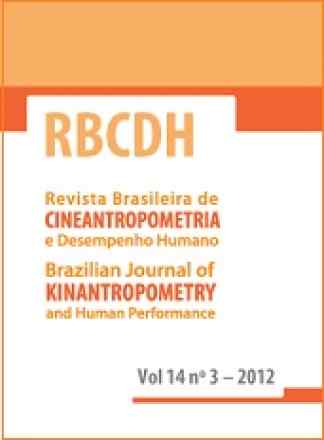Análise eletromiográfica dos músculos da coxa no exercício agachamento afundo até a exaustão
Revista Brasileira De Cineantropometria E Desempenho Humano
Análise eletromiográfica dos músculos da coxa no exercício agachamento afundo até a exaustão
Autor Correspondente: Gisele Rodrigues Leite Garcia | [email protected]
Palavras-chave: ExercÃcio, ExercÃcio resistido, Fadiga, Root mean square.
Resumos Cadastrados
Resumo Português:
O agachamento afundo possui um posicionamento dos membros inferiores
diferencial em relação ao agachamento padrão, necessitando de maiores esclarecimentos
acerca das participações dos músculos envolvidos. O objetivo foi analisar a atividade eletromiográfica
dos músculos vastus lateralis (VL), vastus medialis (VM), bÃceps femoris (BF)
e semitendinosus (ST) durante a execução do agachamento afundo até à exaustão com o
membro inferior posicionado frontalmente e posteriormente. Participaram do estudo nove
mulheres ativas com média (DP) de idade de 22 (3,4) anos e massa corporal 60,3 (4,1) kg.
O agachamento afundo foi dividido em duas etapas, diferindo apenas o posicionamento do
membro inferior dominante (randomizado). Os sinais eletromiográficos foram captados
utilizando um eletromiógrafo e analisados os valores “root mean square†(RMS) na fase concêntrica.
Os resultados indicaram um aumento significativo do RMS em função do tempo
para o membro inferior posicionado frontalmente e posteriormente (p< 0,001). No membro
posicionado frontalmente, o aumento do RMS correspondeu a 50% para o VL, 54% para
o VM e 48% para o BF. O membro posicionado posteriormente apresentou um aumento
de 75% para o VL, 113% para o VM, 62% para o BF e 48% para o ST. O RMS também foi
significativamente maior no músculo VM em relação ao ST no membro inferior posicionado
anteriormente (p = 0,03) e em relação ao ST e BF no membro inferior posicionado posteriormente
(p = 0,02). Não ocorreu interação significativa entre o efeito do tempo e músculo na
atividade eletromiográfica. O RMS normalizado não apresentou diferenças estatisticamente
significativas no que se refere ao posicionamento do membro inferior dominante. A atividade
muscular foi semelhante em ambos os posicionamentos do membro inferior, apresentando
maior aumento de ativação dos músculos VL e VM em relação ao BF e ST.
Resumo Inglês:
The position of lower limbs during lunge is different from squat without clear understanding
on differences in muscle activation. The objective was to compare the electromyographic
activity of the vastus lateralis (VL), vastus medialis (VM), biceps femoris (BF) and semitendinosus
(ST) during the execution of the lunge to exhaustion of the lower limb, changing position of the
legs frontally and posteriorly. Nine active women participated of this study with a mean (SD) age
of 22 (3.4) years and body mass 60.3 (4.1) kg. The lunge was divided in two phases, changing the
forward leg (random order). The electromyographic signals were captured by an eletromyograph,
and the root mean square (RMS) values were analyzed during the concentric phase. There was a
significant increase of the RMS in time for the LL positioned frontally and posterior (p< 0,001).
For the forward position, the increase of RMS was 50% for VL, 54% for VM and 48% for BF. The
backward position had an increase of 75% for VL, 113% for VM, 62% for BF and 48% for ST. The
RMS was significantly higher for VM than for ST the forward position (p = 0,03) and ST and BF
for the backward position (p = 0,02). No interaction was observed between time and muscle in
the electromyigraphic activity. The normalized RMS was not statistically different comparing the
forward and backward position of the dominant leg. Muscle activity was similar in both positions
of the LL, showing increased activation of the VM and VL muscles in relation to the BF and ST.

